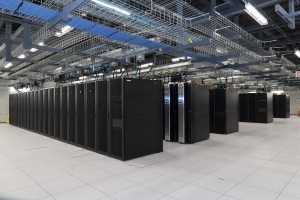In the digital age, data centres have become the beating heart of the information technology world, fueling the digital ecosystem and powering our modern lives. As we've delved into the interplay between data centres, energy consumption, and information and communication technology (ICT), it's evident that the United Kingdom is a formidable player in all three arenas. In our previous discussions, we've examined how IT investments are increasingly shifting toward renewable energy sources and how data centres wield a profound impact on our interconnected world. Today, our focus narrows to the largest data centres in the UK and the staggering amounts of energy they require to serve their clients.
Data centres are the backbone of Big Tech, pivotal for business continuity, and offer enhanced performance and security for hosted data. However, each data centre has its limits, influenced by factors such as location, type, ownership, and the kind of information it stores. The United Kingdom is no exception to this rule, and as we explore the five largest data centres based on consumption, surface area, and the number of servers they house, we'll uncover the colossal energy demands that drive these technological powerhouses.
#1 Next Generation Data Centre
The Next Generation Data Centre, situated in Wales, UK, stands as a monument to technological supremacy. Completed in 1998, it's arguably the largest data centre in all of Europe. Within its vast confines, it accommodates a staggering 19,000 servers, encompassing an expansive surface area of 750,000 square feet. To satisfy its insatiable energy appetite, the data centre boasts a customer power rating of 250 megawatts.
Remarkably, this facility was originally designed to serve the needs of the LG semiconductor plant. Today, its main clientele includes Logica and BT, each of which leverages the data centre’s infrastructure for crucial IT services. Logica, in particular, provides essential IT services to the British government, while BT relies on the centre for various IT-related activities to enhance performance and responsiveness.
One standout feature of the Next Generation Data Centre is its unparalleled power reliability, thanks to a private distribution network of 9 MVA (mega-volt-amperes) directly supplying the data centre site. This unique attribute has enticed customers ranging from mid-level enterprises to large corporations, reinforcing its status as a technological behemoth.
#2 KAO Data Campus
Harlow, Essex, is home to the KAO Data Campus, an impressive facility spanning a colossal 150,000 square meters. This data centre is embedded within a sprawling complex equipped with advanced IT infrastructure capable of supporting and facilitating future expansions for numerous organisations.
With an estimated customer power demand of 100 megawatts, the KAO Data Campus has garnered significant investments, totalling £33 million, with ambitious plans to reach £200 million by 2025. Comprising 16 halls and boasting 500 server rack locations per suite, this centre stands out as one of the few in the UK holding a UTI Tier 3 design certification.
#3 GTP 3 Data Centre
Birmingham hosts the GTP 3 Data Centre, a facility offering a scalable surface area ranging from 10,000 to 40,000 square meters. Built on a five-acre plot, it plays a pivotal role in serving public, government, and enterprise services across the UK.
In addition to supporting these essential functions, the GTP 3 Data Centre extends its services to cloud B2B activities and maintains a round-the-clock maintenance support team to ensure seamless operations. Its estimated customer power demand ranges from 15 to 16 megawatts.
#4 Telehouse North
Originally designed as a disaster recovery site for Japanese banks, the Telehouse North Data Centre has evolved into a seven-story building, offering nearly 100,000 square feet of technical capabilities. This space is divided across five of the seven floors within the facility.
Although colocation rack space is available in clusters, securing dedicated caged space may only be possible when existing clients free up capacity. Cross-connects are now more accessible than before, and copper/Cat5 connections are often feasible between rooms when fibre is not necessary.
Telehouse North has experienced periods of high occupancy, occasionally being completely sold out. Despite its age, the estimated total customer power for this facility stands at an impressive 16 megawatts, securing its position as one of the top data centres in the UK.
#5 Virtus Data Centre
Virtus Data Centre, headquartered in London, represents the epitome of a UK-centric data centre, providing mission-critical facilities with its operational base strategically located in and around London's metro area.
Virtus's London2 data centre is not only a flagship for the UK but also caters to the ever-growing customer base with on-demand colocation services. It currently boasts a capacity of 160 megawatts of data centre space.
What sets Virtus apart is its innovative fresh-air, evaporative cooling technology, which significantly reduces energy consumption and enhances site power usage efficiency (PUE), bringing substantial total cost of ownership (TCO) reductions to its customers.
Data Centre Customer Power and Surface in the UK
In the grand scheme of things, data centres are among the most voracious energy consumers, crucial for the continued digital expansion of our world. These technological giants are the lifelines of modern society, and their energy consumption impacts the state of our planet. The only viable path forward, at present, is to transition toward renewable energy sources, balancing our digital growth with environmental sustainability.
How Many Data Centres are in the UK?
As of June 2022, the United Kingdom hosts a total of 461 data centres. Of these, 70 are concentrated in London, with more than 350 scattered throughout the country. This places the UK in the third position globally in terms of the number of data centres, trailing only the United States and Germany. For a comprehensive list of data centres in the UK, you can refer to https://www.datacentermap.com/united-kingdom/
Additionally, there are 1,480 known data centre service providers in the UK, along with 27 network fabrics. This substantial presence underlines the UK's pivotal role in the ever-expanding world of data centres.
Top 5 Countries with the most Data Centres
Data centres play a pivotal role in the modern world, serving as the backbone for various digital operations. The growth of data centres is closely intertwined with factors such as digital transformation, cloud adoption, and the rise of hybrid working models. In this article, we delve into the global landscape of data centres, with a particular focus on how this industry's dynamics could impact the UK market.
- Canada: With 335 data centres spread across the nation, Canada offers a robust data centre landscape. Toronto and Montreal, in particular, have emerged as data centre hotspots. This could serve as an attractive proposition for UK companies looking to establish a North American presence or enhance their global data infrastructure.
- China: China's 448 data centres, primarily located in cities like Shanghai, Shenzhen, and Hong Kong, underline its colossal presence in the digital realm. This expansive infrastructure could be of interest to UK companies seeking to tap into the vast Chinese market, although navigating regulatory complexities is essential.
- UK: With 517 data centres, including 70 in London, the UK possesses a significant domestic data infrastructure. The country's data centre sector is poised for growth, which may lead to increased competition among providers, potentially resulting in improved services and cost-efficiency for UK businesses.
- Germany: Germany's 522 data centres, including numerous centres in Falkenstein, reflect its prominence in Europe's data centre landscape. UK companies targeting the European market may consider forming partnerships or collaborations with German data centre providers to bolster their regional presence.
- U.S.: The United States reigns supreme with a staggering 5,375 data centres, distributed across the nation. While UK businesses often look to the U.S. for expansion opportunities, they should also assess the potential benefits of utilizing American data centre infrastructure to optimize their operations and enhance global reach.
Being ranked third in the world in terms of the number of data centres is undoubtedly a positive sign for the UK market, with several implications for job opportunities and business growth. However, it also necessitates consideration of how companies are exploring other international options in this competitive landscape.
In conclusion, the global proliferation of data centres presents multifaceted implications for the UK market. As data-driven technologies continue to shape industries worldwide, UK businesses must stay agile and strategically evaluate opportunities and partnerships in both domestic and international data centre landscapes.




